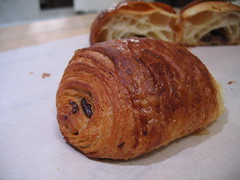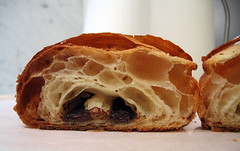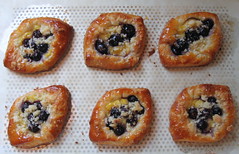For a long time I was scared of using yeast. Although I am still a novice at bread making, the fear has subsided. In addition to learning bread making, I've always wanted to tackle laminated and enriched doughs. Viennoserie is like a happy place where cakes and bread meet. For some strange reason I find Viennoserie less scary than bread. With bread, there is no place to hide my mistakes. It's flour and water (and salt and yeast). With Viennoiserie, mistakes are still noticeable, but the butter, sugar, eggs and milk make those mistakes more palatable.
I was fortunate enough to attend a 5-day Viennoiserie class at the SFBI. I wasn't sure if I could reproduce the results at home without a sheeter, proof box, and high-tech oven, but I was inspired by all the croissants seen on TFL especially txfarmer's amazing croissants. I'm using a scaled down version of the croissant with poolish recipe I learned in class (which I think is from Suas' Advanced Bread and Pastry).

Attempt1: traditional-shaped croissants. Long story short, I used too much butter for the roll-in and I didn't proof them long enough before baking. My shaping skills need work. The croissants have too many shoulders. The layers are not distinct.

Attempt 2: pain au chocolate. I can see some distinct layering and there's some honeycombing. My results were better than those in attempt 1.


Attempt 3. I knew during the lock-in that my beurrage was too hard. But it was too late to turn back and let the butter soften a bit so I proceeded and hoped for the best. I could see that the butter layer was patchy even with each subsequent turn. (Note to self: Always make sure the detrempe and beurrage are the same texture before doing the lock-in.) I was worried about the how the patchiness of the butter would lead to uneven layering and bready croissants. So I used the dough to make blueberry danishes where the breadiness would be less noticeable.

